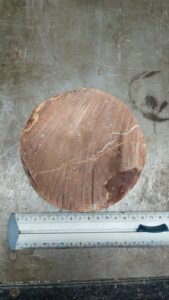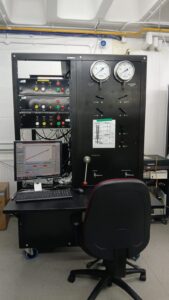
In this blog post, I have interviewed Dr. Isabel Ashman, who is part of the GeoSafe consortium at the University of Liverpool, looking into safe and long-term containment of radioactive waste in geological formations. Dr. Ashman, along with other project partners at the University of Liverpool, aim to better understand how small to large-scale (sub-mm to several km) structural variabilities in target geological formations may impact their ability to isolate fluid and contaminants. My interaction with Dr. Ashman is summarized in a series of Q&As, through which I have endeavoured to understand the role played by geological structures in guiding the selection of geological formations suitable for the construction of Geological Disposal Facilities.
With the world teetering on the edge of a climate crisis accentuated by decades of unmitigated fossil fuel use, there is a pressing need to accelerate a switch to carbon-free, greener sources of energy. Among the many low-carbon energy sources prevalent in today’s world, nuclear power is perhaps one of the oldest and most widely used. Nuclear power-based electricity for domestic energy supply has existed since the 1950s and Calder Hall nuclear power station in Sellafield in the United Kingdom was the first nuclear power station to produce electricity for domestic use. Between 1970 and 1990, nuclear power generation underwent a rapid rise globally, but this trend was bucked significantly following the disaster at the Fukushima Daiichi nuclear power plant, in 2011. Despite the accident at the Fukushima Daiichi, many countries such as Belgium, France and Ukraine continue to rely heavily on nuclear energy for electricity generation.
One of the major issues regarding nuclear power involves the safe, long-term disposal of radioactive waste generated from nuclear power plants. While nuclear power plants are the main source of radioactive waste, significant amounts of radioactive waste are also generated from medical, industrial, research and defence activities. Many countries in Europe such as the United Kingdom, France and Sweden are currently investing in Geological Disposal Facilities or GDFs as a safe and secure long-term solution for the disposal of hazardous radioactive waste. A Geological Disposal Facility involves isolating hazardous radioactive waste in suitable, deep geological formations in engineered vaults and tunnels. Researchers from the rock mechanics and deformation laboratory at the University of Liverpool are currently investigating the feasibility of developing a Geological Disposal Facility within the United Kingdom as part of the GeoSafe consortium, a National Environment Research Council (NERC)-funded project based on ‘derisking geological disposal of radioactive waste in the UK’.
In 2022, the UK had a reported total of 4,450,000 cubic metres packaged volume of radioactive waste materials. UK policy and international safety guidelines recommend the use of a geological disposal facility (GDF) for the long term (~1 million years) disposal of Intermediate- and High-Level Waste (ILW & HLW). Target host rocks for a GDF must act as effective barriers that extend the travel time for radionuclides to return to the biosphere through low permeabilities, and the inhibition of radionuclide mobility.
- How would you describe your role within the GeoSafe consortium, looking into radioactive waste disposal in the United Kingdom?
The GeoSafe consortium was funded as part of the ‘Derisking geological disposal of radioactive waste in the UK’ funding call from the National Environment Research Council, UK. The consortium consists of several universities within the UK, including Imperial College London, the Universities of Leeds, Manchester, Liverpool, Heriot-Watt University along with the members from the British Geological Survey and the UK National Nuclear Laboratory. I am one of the postdocs employed on this grant and my work is based on challenge 1 of the grant, which involves characterising the structural heterogeneity of mudstones on a range of scales and investigating pathways for fluid flow through these rocks.

Drill core from a mudstone studied as part of investigations into rocks suitable for the construction of a Geological Disposal Facility. Photo copyright held by Dr. Isabel Ashman.
2. Why did you choose to work on radioactive waste disposal?
I suppose I chose radioactive waste disposal as my postdoctoral research theme because it is quite different to my PhD research on earthquakes and it is more like blue sky research! The issue with radioactive waste disposal is that we already have radioactive waste in storage and the stored volume of radioactive waste is only going to grow from waste generated by the nuclear reactors that are going to be shut down in the UK over the next 10 years and there needs to be a solution to where all this radioactive waste goes. So it feels really good that I am doing research that contributes to properly solving this problem!
3. What sort of experiments do you perform to assess the feasibility of radioactive waste disposal?
To investigate critical flow pathways within geological formations deemed suitable for Geological Disposal Facilities, I perform 2 types of experiments. I conduct permeability measurements to determine how well fluid flows through a rock, using pore pressure oscillation that involves closing off one end of our sample to the control system on our triaxial deformation apparatus and a sinusoidal pressure wave is applied to the other end of the sample. I then observe how much of the applied pressure wave is registered on the side of the sample closed to the control system and this enables us to estimate the permeability of the sample. The other type of experiments I conduct involves the measurement of stress conditions at which the samples of interest start to yield. We need to know the strength of the rocks because when a Geological Disposal Facility is excavated, it is going to change the stress state of the rocks in its vicinity because of the void space created. To assess this, we perform yield experiments wherein we put rocks under a certain confining pressure and pore pressure and we apply an axial load using a loading column in our deformation apparatus. We can then measure the stress response to the imposed strain. In non-linear regions, the porosity within the sample begins to collapse and grain crushing is initiated. This is the point at which porous rocks begin to fail. Once the failure criterion has been established, the sample is removed and by changing the confining pressure I can measure where the rock yields for a range of effective pressures.
4. How do you expect your experiments to guide radioactive waste disposal in the future?
The GeoSafe consortium is an academic research group but we are working in close collaboration with Nuclear Waste Services and the UK National Nuclear Laboratory, and they are the government agencies who will have to construct the Geological Disposal Facility within a few decades’ time. Our experimental results from the GeoSafe project will be fed into future work packages that will involve modelling the target rocks from the micro scale to larger scales up to the scale of the actual Geological Disposal Facility. The data that I am currently collecting would inform those who shall be constructing these models about the permeabilities of these target geological formations so that they can incorporate these values into their models which would then shed light on whether a hypothetical Geological Disposal Facility constructed in the modelled geological formation would remain isolated from subsurface fluid flow on temporal scales up to a million years.

The deformation apparatus used by Dr. Isabel Ashman to experimentally investigate the feasibility of constructing Geological Disposal Facilities within suitable geological formations from the United Kingdom. Photo copyright held by Dr. Isabel Ashman.
5. What is the most difficult aspect of studying radioactive waste disposal in a geological context?
We are investigating 3 different rock types targeted for radioactive waste disposal that range from really strong crystalline rocks, low-strength sedimentary rocks and evaporites, the aim being to study how well these rock types isolate radioactive waste. These rocks inherently have very low permeability, so to measure permeability in these rocks, experiments have to be run for a really long time! There is also the problem of friability, especially with the low-strength sedimentary rocks that I am studying that makes sample preparation a significant challenge. Another potential issue lies with upscaling the results of our laboratory measurements, be it deformation experiments like mine or radioactive absorption tests that some other members of GeoSafe are doing, to the scale of an actual Geological Disposal Facility.
6. Could you recommend relevant research that readers might want to look into if they were to take an interest in Geological Disposal Facilities?
If you are interested in the push to dispose of radioactive waste in the UK itself, Nuclear Waste Services is a government agency who publish all their results and reports online. They have current resources relevant to plans for a Geological Disposal Facility within the UK, methods employed behind choosing a site for a Geological Disposal Facility and community resources. Finland have already started the disposal of radioactive waste in a Geological Disposal Facility at Onkalo. Posiva, the company undertaking the disposal of radioactive waste at Onkalo, have made plenty of resources available online. Similarly, Nagra is a Swiss company dealing with radioactive waste disposal in Switzerland, who have plenty of resources on their webpage.
Readers who want to know more can also reach out to Dr. Ashman at Isabel.Ashman@liverpool.ac.uk and on Linkedin.

